QuestionQUESTION: My horse is a 16 hand, 15 year old quarter horse gelding, named Buggs. Within the last six months, he has been very difficult to the jumps. He tends to throw his head up, and then yank it down, and if often unseats me. He is a very sensitive horse, and I really try to adapt my riding style to meet his needs. I sit lightly in the saddle, don't hang on his mouth, but rather maintain a firm yet giving contact with the bit (which is a Dee Mullen Barrel Bit). Yet when I approach the jumps (now less than one foot cross rails) he tries to gallop towards it, and if I make him trot or canter it, he will swing his body around, almost swiveling so that when we reach the jump, he is either completely turned around or sideways. I have always considered myself a pretty calm rider, but he makes me nervous when he does that; I can feel his body fighting to leap out from under me. So, although I used to be able to jump 2'6" courses with him, I now do very small single cross rails. And I don't think it's solely me, because none of the trainers at the barn can ride him well either. I changed my saddle to have a wider tree, and although he seems to like it, he still races at the jumps and swivels his body and yanks his head down. I have been working just on walking up to about ten feet before the jump, and then asking him to go into a relaxed trot, and sometimes he'll do it, but other times he'll race at it. The owner of the barn, a very experienced horsewoman, says that he just loves to jump. He'll jump anything, but on his own terms (racing full speed ahead). I try not to be repetitive; once he's done something right, I move on. I am at a loss of what to do. Is there anything that you suspect I am doing wrong? I know that Buggs loves to jump, and his tack fits him well. His feet have been checked, along with his back. Although his feet are soft, he has great shoes to help protect his front feet. Do you have any suggestions to help me keep him quieter to the fences?
ANSWER: Hi Meg!
Buggs is taking over and leading the dance! He believes he has a much better plan than you do about how to get through the day! This behavior is also building tension for the both of you and it will develop to the point of refusals! You can't properly navigate a fence sideways! This is an issue of basic obedience, relaxation, and trust.
Do NOT take the fence if your horse is not relaxed and calm. Simply circle, roll him over his hind quarters and yield his hind quarters until he can let down and RELAX! Jumping with this much tension will create lameness and pain very quickly! Your horse is not with you. You are not jumping as a team. I would only take the fence when Buggs is light, collected, round, and soft. Set things up in your arena so that you have may options for coming to the fence. Make most of your school at the trot. Work on being very soft and round with lots of walk, trot, back transitions as well as rolling over the hind quarters to change direction. Make sure you are riding in one rein only with a feather for a supporting rein. If you are pulling on both reins you are creating tension and a brace. Make sure YOU are riding the horse! This means lots of changes in tempo, direction, gates and speed. Work on lengthening and shortening the stride. All of these things need to be done in and around the jumps. When your horse is mentally with you, relaxed and focused, THEN and only then do you jump the fence. Try angle/angle combinations. With these you will have to leg yield for proper postilion. If you are not relaxed continue the leg yield and do not jump the "B" element of the fence. I'm wondering how good your ground work is with this horse? Do you use your flag, tarp and slicker every day prior to riding? Jumpers must be bold with confidence to spare. Lots of running to the fence is fear based. The horse wants to get it over with as quickly as possible. This behavior is often misunderstood and taken as really loving to jump when in reality it is fear based. Again, never go to a fence unless you and your horse are relaxed, soft and secure. You play how your practice, now is the time to fix things up for success. Make sure you are doing a good job with your ground work prior to every ride. Make sure you are really getting to the feet, so you know you are getting to Buggs mind.
Give me a shout and let me know how things are going. If I have used terms or concepts you do not quite understand, let me know and I will clarify!
Smiles! Denise
---------- FOLLOW-UP ----------
QUESTION: I believe you're totally right with the fences being fear-based. The owner of the barn that I ride at says he's just an over-eager jumper, but I don't think so. In my lessons, we always ride past the jumps, and do lots of ground work before jumping, such as: sitting trot, circles, alternating between posting, sitting, and two-point at trot, canter, and we do everything in both directions. But after a while, he will get upset -even on the ground. He dislikes the sitting trot, especially without stirrups -and will eventually try and canter or go faster. I believe this is probably my fault though -I am not great at the sitting trot. I only take the jumps at the trot now, because he will race out of control if I canter it. Often times, he is just as spirited on the flat as he is over fences, but I have been working on keeping him calm and relaxed and collected. Also, I forgot to mention the special way I have to ride him: I have to use direct as well as indirect rein (almost like in western -move inside rein against neck), cannot sit on his back fully at posting trot or canter -must be always touching very lightly. Without special help to turn, he will run into something. Is that normal? Buggs is such a great and willing mount; he would never do anything to hurt me. As for coming to the fences, my trainer says to keep going to it no matter what. Is this wrong?
For Clarification:
- rolling over the hind quarters/yield hind quarters
- How do I use a flag, tarp, and slicker
- getting to the feet
I am sorry to be bothersome, but I am desperate for help with my horse. He is amazing, and I love him to death, but his behavior is an indication that something is wrong.
AnswerHi Meg!
NO, do NOT keep going to the fence if your horse is not soft, round and totally with you! That is just silly. He will start taking down rails and full fences! Crazy! If he an Event horse it would mean pure disaster. By going to the fence "no matter what" you are training him to be careless! Yikes!!!
It sounds to me like Buggs is really lacking some basic kindergarten education. This happens so much with horses. They are shoved off to college without ever having been to grade school. It just does not work out. So, Meg this is what I want you to do. Since you do not understand some very basic horsemanship concepts (shame on your coaches!) we need to go back a ways before you can come forward with QUALITY! Your horse needs to go back to the round pen. Put up your jumping saddle for a while and find a good ranch saddle. Your horse is not really ready to jump with quality anyway. You need a much more secure seat and he needs for you to stop crashing into his back with a saddle that is built for very subtle and specific cues. A good ranch saddle with a wade tree is what you should be riding in for a while. It is what we start all of our horses in and we only use our dressage saddles just prior to a show and at the show. The same holds true for our jumping saddles. For most of the school we are in our slick fork saddles and then change for jumping. It works great.
Homework: "Ground Work" DVD by Buck Brannaman and the "Ground Work" book by Buck as well. The book is very small and to the point. No wasted words or junk, just the real deal. This will show you very clearly what hind quarters looks like. I an gong to tell you, but I want you to see it as well. Hind Quarters (HQ) you comb down your inside rein, while using your inside leg to bump just in front of the flank, bend your horse using a "feel" until his head and neck are deeply bent, keep his ears level, his nose should almost be at your toe, with his nose perpendicular to the ground, to get this bend bring your inside hand up toward the front pocket of your breeches, right at your hip bone. This movement isolates the hind quarters and causes the HQ to disengage. It is like stepping in on the clutch of your car, the engine can rev, but your can't rocket over the edge of the cliff! You need to make sure this is a forward motion and never back! The inside shoulder needs to be elevated and the inside front foot must continue to step forward. There should be no drift to the outside as this could cause your horse to tip over. If your horse is starting to feel "tippy" open up and go forward, then bend again correctly. Following a "feel" means you are not pulling on your horse with pounds of pressure. It means through a series of pressure and release, your horse follows the weight of the rein as you are asking him to bend. This is the level of refinement you need to have when jumping. The softness in the bend must go to the FEET! The rein has to mean something to the FEET first if not you will pull your horse right over. When you pick up on an inside rein it must mean to the horse: yield the hinds by having the inside hind foot reach up and under the body while maintaining an elevated inside shoulder. The movement looks similar, to the untrained eye, to a pivot on the forehand. The major difference being that the inside front foot is not planted. The inside front foot is stepping in a small, elevated, circle while the hinds are traveling in a larger forward circle eventually traveling around the front. You will see this clearly on the DVD. Rolling over the HQ means you yield the HQ and you do not come to a complete stop. Your roll your HQ until you are heading in a new direction and then smoothly carry on.
Getting to the feet is just that...your aides hands, reins, feet legs must mean something to the HORSES FEET. When you can control the feet you can control the life and energy in the horses body and the horses MIND. For example if I use an open leading rein it must mean to the horse that I want the inside front foot to follow the feel of my rein and lift off the ground, reach up and over with the horses body weight being shifted back and over the hocks primarily over the outside hind leg...guess what this is the beginnings of a turn on the haunch, a spin and a pirouette! I want my feet and legs to be my horses feet and legs. I want to establish the connection between the rein and the horses feet. The feet are the most important aspect of doing anything with the horse. It is where the energy of the horse comes in contact with the ground. It is where the exchange of energy takes place and allows all movement to happen. You can only influence the movement of the horse when the foot is in the air. So, you need to be aware, with your eyes closed, when the feet are leaving the ground and when they are striking the ground. This is called counting cadence. Practice every day calling out when each of the feet are leaving the ground and when they are striking the ground. Have someone watch you and help you with this. I want you so good at this that you can call out what each foot is doing by feel alone. Start with the left front foot first and work on all four feet. This is a great exercise to do with your horse throughout your school when the horse needs time to soak on some of the other things you have worked on.
Using the flag, tarp and slicker is just another way to help your horse build confidence with the unknown. Some people call it desensitizing the horse. I prefer to have a very sensitive horse that is confident! I don't want to ride a dull horse! I want a horse that IS sensitive but confident, secure and in tune with me as a partner. Big difference. I think your horse will start out very troubled with the flag. I think he lacks confidence, so you will have to take your time with him and use your flag every day. Most tack stores now sell flags or you can make one of your own with an old dressage whip and a small plastic bag or scarf. This is just an extension of your arm and you can expose your horse to different things and stay safe. You have to first teach your horse to yield his HQ. Then using your rope halter with a 12' tree line lead, ask him to walk a good forward walk around you in about a 10m circle. You will start by sending your horse to the left, hold your lead in your left hand and your flag in your right with the flag in neutral position over your right shoulder. Then ever stride or two, take your flag off your shoulder move it down by your left elbow back to the right and then back to your shoulder. At this point I do not want your to point it toward your horse or on your horse at all, just in front of you and back to neutral. If your horse get really bothered and I think he will, yield his HQ send him to the right and left until he relaxes and then continue to expose him to the flag. You will see this (I think if memory serves) in the dvd as well. Never yank on your horses head or try and make him stand still for this. This just creates a trapped feeling in your horse and causes him to become more worried! Allow him to move! If your feel and timing are good pretty soon he will offer to stand still. This is the process of making our idea the horses idea! How nice to have all of these things become the horses idea! How nice to get to the point where jumping a fence soft, round and calm becomes your horses idea! This is where it all begins. Soon you will be able to rub your flag all over your horse in his flanks down his legs. Be very careful about getting into and out of blind spots like the one under the horses chin, and under the chest by the front feet, quickly and smoothly. Do not stay so long that it creates more trouble for your horse. This is the part of learning to have a feel around your horse. It is something you have to find on your own, just you and your horse.
So! Watch the DVD's start with Bucks ground work stuff first, then move on to Ray Hunt and Tom and Bill Dorrence. This will make a world of difference for you and your horse! Meg, you are NOT bothersome! Your questions are honest and from the heart! I'm more than happy to help, keep the questions coming, no big deal! Give me a shout and let me know how things are going!
Smiles! Denise
Sorry, didn't mean to give you a novel here!

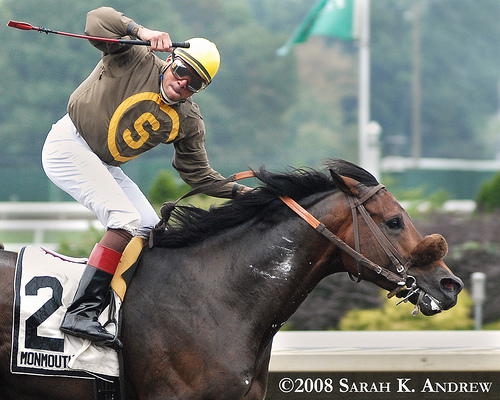 foamy sweat
Question
foamy sweat
hello maam, is this foamy s
foamy sweat
Question
foamy sweat
hello maam, is this foamy s
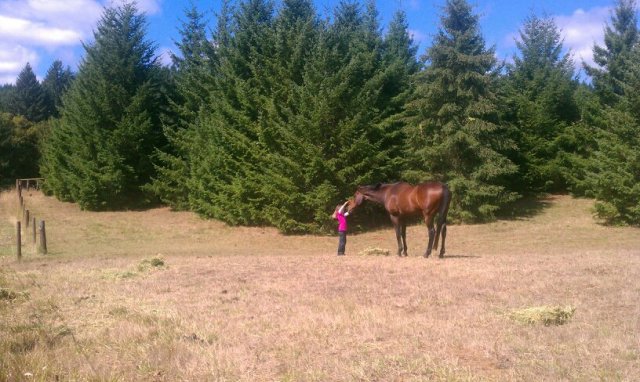 welsh 2yr old
QuestionHi there, was just reading a post about a lady
welsh 2yr old
QuestionHi there, was just reading a post about a lady
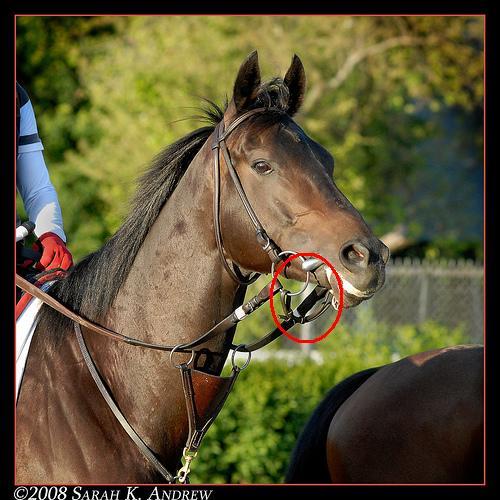 chin straps for horses
Question
chin strap
hello sir, what is the use of chin
chin straps for horses
Question
chin strap
hello sir, what is the use of chin
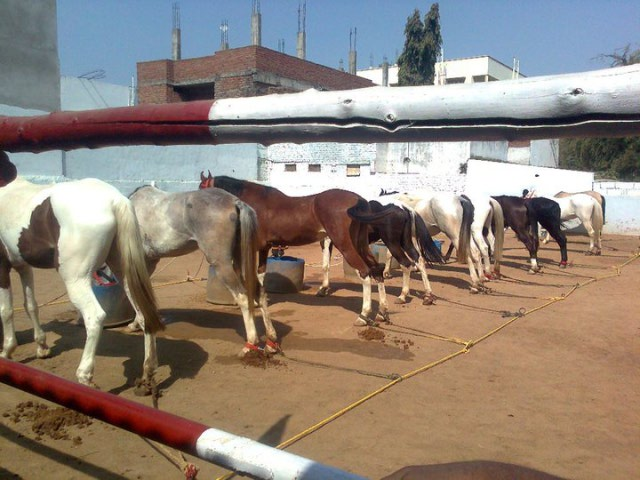 horses made to park
Questionhorses parked
QUESTION: hello maam, have
horses made to park
Questionhorses parked
QUESTION: hello maam, have
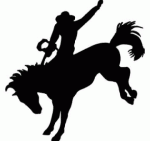 breaking a yearling
Question
breaking yearling
hello. may i know why cow bo
breaking a yearling
Question
breaking yearling
hello. may i know why cow bo